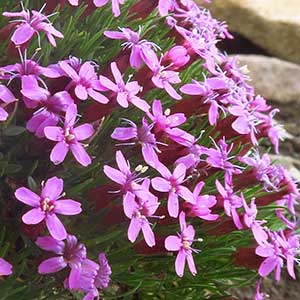Silene acaulis
Silene thurberi
moss campion, silène acaule
Thurber's catchfly, woolly catchfly
several, erect, freely branched, leafy, elongate, 30–80 cm, scabrid-puberulent and glandular-viscid.
erect, leafy proximally, 3–6(–15) cm, old leaves persistent at base.
mostly basal, densely crowded and imbricate, sessile;
blade 1(–3)-veined, linear-subulate to lanceolate, 0.4–1(–1.5) cm × 0.8–1.5(–2) mm, margins cartilaginous, often ciliolate especially proximally, apex acute, glabrous to scabrous.
2 per node;
basal long-petiolate, blade oblanceolate, (2–)5–18 cm × 5–30 mm, base narrowed into petiole, apex ± acute, glandular-puberulent on both surfaces;
cauline not greatly reduced in distal stem, blade 5–15 cm × 10–20 mm, viscid glandular-pubescent, sparsely so in shade forms, proximal petiolate and blade oblanceolate, distal sessile and blade lanceolate, apex acute.
solitary flowers.
open, elongate, dichotomously branched, branches ascending, bracteate;
bracts leaflike, reduced distally.
2–40 mm.
ascending, may be partially deflexed, rather slender, longer than calyx, viscid glandular-pubescent with septate hairs, septa colorless.
bisexual or unisexual, all plants having both staminate and pistillate flowers, others having only pistillate flowers, subsessile or borne singly on peduncle;
calyx 10-veined, lateral veins absent, tubular to campanulate, (5–)7–10 mm, herbaceous, margins often purple tinged, dentate, sometimes ciliate, ± scarious, glabrous, lobes lanceolate to ovate, 1–2 mm;
petals bright pink, rarely white, limb unlobed to shallowly 2-fid, 2.5–3.5 mm, base tapered into claw, auricles and appendages poorly developed;
stamens exserted in staminate flowers, not so or aborted in pistillate flowers;
styles 3.
calyx prominently 10-veined, tubular in flower, 8–12 × 2–4 mm, swelling to campanulate and 5–7 mm broad in fruit, not contracted proximally around carpophore, viscid glandular-pubescent, especially on veins, veins parallel, green, with pale commissures, those to lobes broadened distally, lobes erect, narrowly lanceolate, 3–4 mm, rigid, setose-scabrous, glandular-viscid, apex recurved;
corolla greenish white, claw equaling calyx, limb 2-lobed, ca. 3 mm, appendages ca. 0.5 mm, margins erose;
stamens equaling petals;
styles 3, equaling petals.
3-locular, cylindric, equaling or to 2 times calyx, opening by 6 recurved teeth;
carpophore ca. 1 mm.
slightly exserted from calyx, narrowly ovoid, opening by 6 teeth;
carpophore 1–2 mm.
light brown, reniform, 0.8–1(–1.2) mm broad, dull, shallowly rugose.
almost black, ellipsoid-reniform, ca. 1 mm, coarsely papillate;
papillae inflated.
= 24.
= 48.
Silene acaulis
Silene thurberi
Silene acaulis is a variable species, and most workers have recognized infraspecific taxa in North America: subsp. acaulis (subsp. exscapa and subsp. arctica), which is predominantly arctic; and subsp. subacaulescens, which extends down the Rocky Mountains from Alaska to Arizona and New Mexico. In subsp. acaulis, the leaves are flat and short and the flowers are subsessile and smaller in size. Subspecies subacaulescens is typically a larger, less-compact plant with longer, narrower leaves and larger, pedunculate flowers. However, in many populations, these two variants are poorly differentiated, and in others both occur together, connected by intermediates.
Silene acaulis is widely distributed in arctic and alpine Europe.
(Discussion copyrighted by Flora of North America; reprinted with permission.)
Silene thurberi is a rare, coarse, scabrous, and viscid herb with small, inconspicuous flowers on elongate pseudoracemes or open dichasia. The veins on the small calyces are usually green and conspicuously broaden into the recurved teeth. It is more common in Mexico.
Silene rectiramea is very similar but differs in its somewhat smaller calyx; short, ovate calyx lobes; and entire corolla appendages.
(Discussion copyrighted by Flora of North America; reprinted with permission.)


